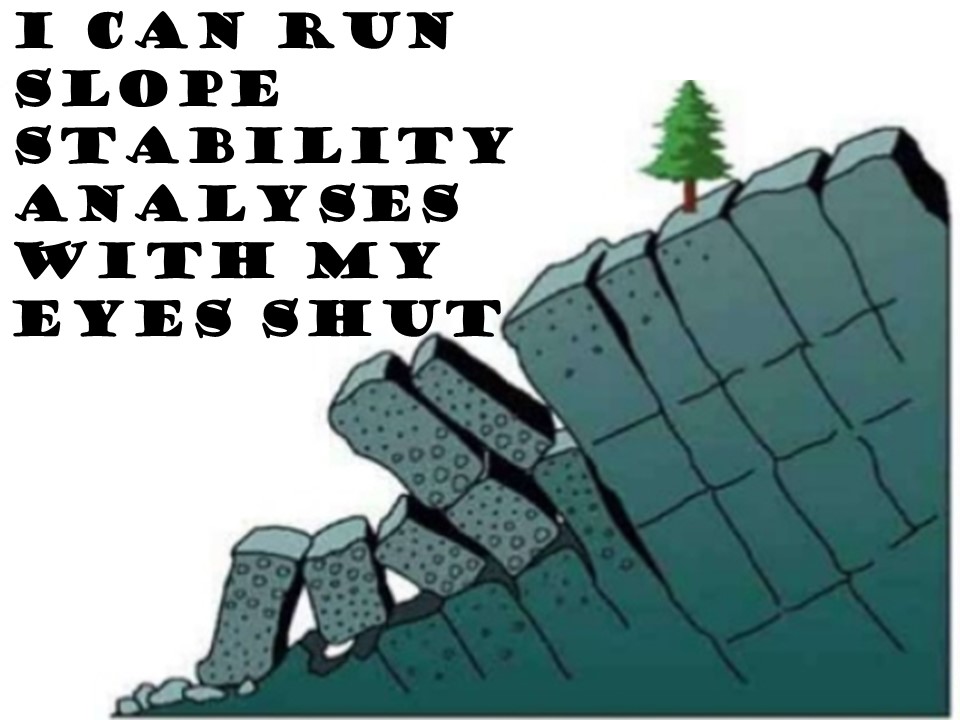
The following text is based on a previously unpublished article that I authored in 1995. I’ve made only very minor edits to the original version, and that was only to add a few things here and there.
In this day and age, with the aid of computer programs, it is quite simple to conduct a slope stability analysis. In fact it may be too easy. As young engineers are brought into the field of geotechniques, it is very common to set these new employees on their way to conduct stability analyses with a minimal about of training. Typically, stability analyses are seen as being dull, routine and repetitive. This being the case it is understandable that untrained staff may be given these tasks.
It is not uncommon for an engineer with a minor understanding of slope stability to train another engineer to do the same. This may result in a serious condition, since less and less information is passed from person to person.
One has only to peruse the literature from recent conferences to realize the rate at which embankments suffer some degree of instability. Such events, while providing tremendous information on the behavior of soils, give a black eye to the industry, and force the unnecessary expenditure of monies. Failures have been documented to occur at every stage of an embankment’s life, including during construction, at completion of construction, and during the operational period. And for a tailings dam, after operations have ceased.
If Dr. Suess were a civil engineer, he may have written a book by the same title as this paper. But in all likelihood, he would have concluded that one should approach such an analysis with their eyes fully open.
In order for an engineer to fully understand slope stability, it is imperative they have a good understanding of soil mechanics. That understanding must include both laboratory and field behavior of soil. If one uses the correct laboratory strength values in an analysis, but an improper failure mode, the analysis is of little use in the real world. The same is true for the reverse case.
Whether it is most appropriate to use the drained or undrained frictional strength depends on a number of factors, including the period of time for which the analysis is meant to represent. There are various sources of information available to guide the stability user in this area. There are countless areas in which the engineer must take note of laboratory test results. Just because the laboratory technician has assigned a friction angle to a soil does not necessarily mean that it should be used in a stability analysis. For instance, if the soil is very brittle, it may not be appropriate to use the peak shear strength. Perhaps it would be more appropriate to use a shear strength other than the peak. Unless the material is exhibiting a propensity for flow (static) liquefaction.
It is equally important to ensure that the correct failure mode is chosen for the analysis. For instance, a circular failure may not adequately represent the critical case if a relatively thin, weak layer underlies the slope. Logic must be used to determine the type and positioning of the failure surface. The fact that computers are quite capable of searching for hundreds of thousands of failure surfaces is not reason to replace logic with computer power.
Even something as simple as the geometry of the slope is often initiated improperly. When one refers to the critical cross-section, the maximum section is not necessarily implied. Perhaps another location has a feature not represented in the maximum section. If this is the case, it may be wise to analyze more than one case.
Each step in a stability analysis must be set up properly. Phreatic surfaces, pore water pressures, failure surface location and mode, material properties and slope geometry must all be specified. Never is the term garbage-in-garbage-out more appropriate than in the case of slope stability analysis.
It is encouraged that all experienced engineers with adequate insight into the problem of slope stability pass their knowledge on in a consciences and thoughtful manner. It is a matter of great importance that engineers learning the art and science of slope stability are trained and supervised with a great deal of attention.

